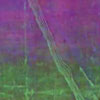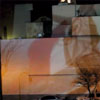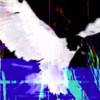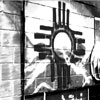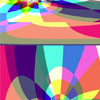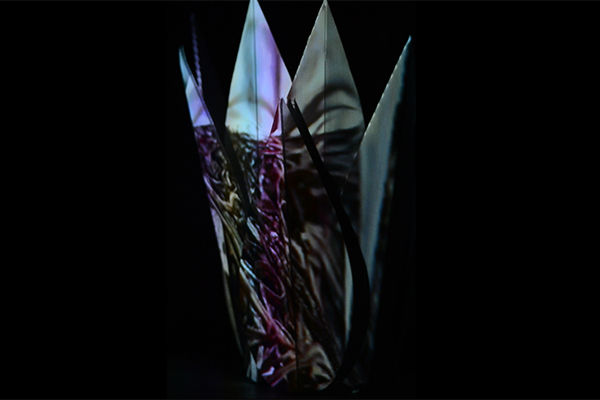
El Agave is an immersive interactive environment that incorporates the use of video mapping projection and sensors that allow audiences to elicit a response from the Agave sculpture. As participants walk through the space their proximity, speed, and height will inform the programming language to create correlating visuals and audio. TÓ ÉÍ ÍÍNÁ ÁT’É water is life- it connects us; cleanses us; fosters growth, and nurtures the world around us. This concept of connectedness is translated through our use of specific New Mexico water sites including the Rio Grande, Carlito Springs, Cochiti Lake, and monsoon season rain. The visuals are also site specific abstractions from Pueblo and Diné land, respectively.
In the southwest, the agave is one of the few plants that not only survives, but thrives in harsh environments. As women of color we are constantly faced with racist and sexist environments that often leave us to adapt and create our own domain. El Agave is a response to that environment and invites audiences to participate and interact in that space. Furthermore, by using floral elements El Agave is a reference to femininity, growth, and survival. It is an opportunity to curate our experience and embrace the connection between culture, land, and the art of interaction. We invite participants to a playground-like space that encourages playfulness, thoughtfulness, and exchange of ideas surrounding aforementioned concepts. Our goal is to create a safe space where people are encouraged to interact with feminism, land, and connection.
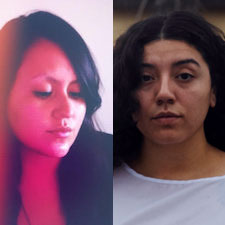
About the artists
Britney A. King is a Diné digital artist that uses a variety of video, projection, projection-mapping, and glitch art techniques to create her work. She is influenced by the re-mix culture movement that she interprets as re-mixing her culture, emotions, and experiences that manifest themselves through abstract projection mixes. Jennifer Nev-Diaz is a new media artist currently focusing on creating immersive, interactive environments based out of Albuquerque. She was born in Los Angeles, Nev-Diaz and lived in South Central well into her teens before spending a few years in rural New Mexico. By blending various mediums such as photography, programming languages, video, sound, and more she invites the viewer to create unique experiences. She is heavily influenced by surveillance art, feminism, and the intersection of art and technology.
Skills Applied
 VIDEO MIXING
VIDEO MIXING
 AUDIO VISUALIZATION
AUDIO VISUALIZATION
 CODING
CODING
Message From The Artist
Both of our work began with concepts relating to memory, trauma, and feminism. It wasn’t until we were faced with an opportunity to create a piece that bridges the gap between art, land, feminism, and connection that we decided to collaborate. We both grew up in rural areas that emphasized the importance of water and the connection between land and life.
I (Jennifer Nev-Diaz) grew up in Los Angeles surrounded by concrete and industrial buildings but I have always been drawn to nature. While in Mexico, my family primarily was surrounded by nature, farmlands, and a connection to the landscape. As a first generation American I was taught to tend and care for the landscape around me and respect the environment. My culture has informed the way I interact with this world. 10 years ago I moved to New Mexico where I found a deeper connection to place. My work is influenced by the spaces I occupy and my relationships to them.
I (Britney A. King) was born into my first clan Tábaahá (Water’s Edge Clan) and grew up on my grandmothers land in Churchrock (Díne / Navajo Nation) where water was hauled by a truck and wasn’t readily available. The scarce of water informed my sacredness of water and emphasized the relationship between life and water.
El Agave is the result of this sacred connection between land, water, and connection.
TÓ ÉÍ ÍÍNÁ ÁT’É (water is life)
STEMarts Design Tool
The Stemarts Design Tool provides a step-by-step tool to help you come up with a design concept for an installation or sculpture inspired by the work of Paseo artists. Explore the artist’s work and theme to understand what makes it unique. Research the science and technology behind the art to inform your design. Then experiment with the related hands-on activities and tools provided in the STEAM wiki to better understand the artist techniques and process. Finally, Brainstorm with your peers to come up with ideas, and create an Installation Design Concept to share with your school. This tool will take you through each stage of the process. Just click on Explore to get started!
Explore light and motion as a tool for social change.
Britney A. King and Jennifer Nev-Diaz design installations that use light and motion to communicate deeply personal messages for social change. In their installation, El Agave their goal is to create a safe space where people are encouraged to interact with feminism, land, and connection. In this activity you will come up with a Design Concept for an installation that incorporates light and motion to explore the festival theme of connection. The first step is to explore this artist page and STEAM wikis below, and search online, to better understand this genre of art called ‘participatory art’ or ‘interactive art’. Make a note of any installations that you like or do not like. At the end of the exploration review all your selections and reflect on the aspects of the design that you would like to investigate further.
Research the science and technology behind the work.
The artists use video mapping projection and sensors that allow audiences to elicit a response from the Agave sculpture. As participants walk through the space their proximity, speed, and height inform the programming language to create correlating visuals and audio. Check out the STEAM wiki below to try out some of the DIY microcontoller and interactive sensor experiments. What can you learn from these resources and the artist’s process? Even though this project does not require building the installation, it is still important to have an understanding of the materials and technology available in order to get ideas.
Brainstorm and experiment to see what’s possible.
Once you have identified the type of genre/installation that you resonated with and have gotten inspired by the possibilities you can start brainstorming on ideas for your own motion sensor interactive installation. Explore all the STEAM wikis below which include some fun technology tools that the artist used and other ideas for materials. Start sketching out concepts and jotting down notes with ideas for an installation. Don’t try to edit at this point. Start a sketchbook just for this project and write or draw anything that comes to mind. This is where you let your imagination run wild!
Get Feedback and iterate.
This is the time to share your concept with peers and experts to get feedback and see how you can improve your design. Practice describing your concept. Discuss and listen to other people’s ideas and remain open to all new possibilities. There will be a lot of trial and error until you arrive at the final design. This stage is especially important to be sure your technical or engineering ideas are feasible. Check our Feedback Tool for some tips.
Create a design concept for an motion responsive projection.
The next step is to do a final drawing that communicates your design for an interactive installation. This could be done by hand or on a computer. The design should show what it will look like and the materials and technology you would use. It would consider possible sites and how people would interact with it. It can include diagrams, text, photos or anything you like. Most importantly it would show how your interactive installation explores the festival theme of connection. Since an installation is multidimensional you will have to find a unique and creative way to communicate your installation concept.
Share your concept with your school and visiting artist.
Once all the student drawings are complete they can be displayed in your school. It is fascinating to see the many different ideas and solutions. You can learn a lot by noticing different design approaches and you can share with the artist when he visits the school. Have fun and don’t forget to share your work with us in the form of photos or videos! We would love to see what you learned.
STEMarts Wiki
The STEAM-wiki is a place to get started with your artist research. You will find links to articles, images, video, and tutorials that relate to the work of Britney A. King and Jennifer Nev-Diaz.
You can search by clicking on the links below or you can click on the topic words in the word cloud for specific areas of interest. For example, INTERACTIVE VIDEO MAPPING to see more examples of this type of art. If you are looking for STEM + Art activities type in STEAM Activities. To view all options, use the keyword ALL.
Remember the resource is an open forum sharing links and ideas that others have found – always check your sources and give credit where credit is due. The open source movement generously shares its knowledge and relies on user feedback – so if there’s something really good or doesn’t work let others know.
adaptation agave arduino artist artists art term audio-visual climate change coding creativity desert adaptation digital art digital literacy earth ecology environment environmental art flows geometry human impact installation installation art interactive interactive art interactive projection mapping LED lesson light math microcontroller mixer model motors New Mexico problem solving process project projection projection mapping public art real-time remix Rio Grande rivers sensors site-specific STEAM activity technology tracking tutorial Video video art video mapping video projection mapping View All water watershed


